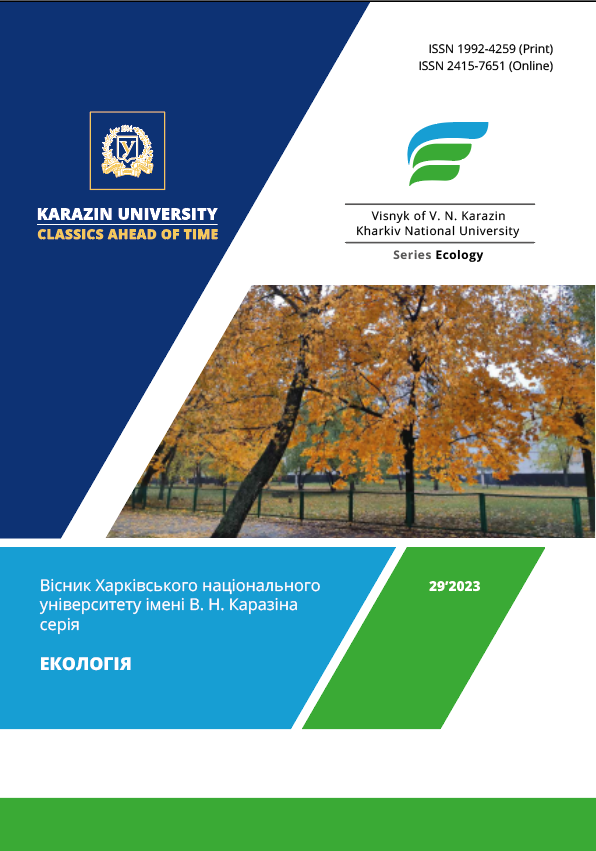Assessment of the effect of heavy metals on the imbalance of growth processes
Abstract
Purpose. To determine the phytotoxic properties of model solutions of heavy metals (Cd, Pb, Ni, Cu) on the growth of roots and sprouts of the test plants of oats Avena sativa L. as a representative of monocotyledonous cereals and radish Raphanus sativus L. as a representative of dicotyledonous broad-leaved plants.
Methods. Statistical, model solutions, test plants, biotesting.
Results. As a result of phytotoxicity of model solutions of heavy metals Cd, Pb, Ni, Cu on Avena sativa L. test plants, it was established that there is no imbalance of growth processes when using solutions with concentrations of 1 MPC and 5 MPC. With an increase in the concentration of model solutions, there is a gradual inhibition of the growth of sprouts and especially the roots of the test objects. The most toxic effect on the test object, according to the research results, was caused by Cd - a phytotoxic effect from weak to strong was observed under the influence of different concentrations of model solutions. Experimental determination of the phytotoxic properties of model solutions of heavy metals Cd, Pb, Ni, Cu on test plants Raphanus sativus L. showed that the imbalance of growth processes is absent only when using solutions with concentrations of 1 MPC and 5 MPC Cu, i.e. practically without exceeding the regulatory requirements for soil quality. Model solutions of Cd and Cu 40 MPC had the highest degree of imbalance in the growth processes of the test plants Raphanus sativus L. – strong for the experimental study we conducted.
Conclusions. Biodiagnostics using Raphanus sativus L. test plants revealed signs of toxic effects where Avena sativa L. test plants did not experience inhibition, or the determined phytotoxic properties of the model solutions were lower, which is determined by the imbalance of growth processes. The above-mentioned discrepancies between the results of biodiagnostics of model solutions with the help of different test cultures make it possible to assert that it is necessary to introduce a comprehensive indicator for determining the phytotoxic properties of the studied samples, with the help of which it is possible to level such discrepancies.
Downloads
References
Kryvytska I. A. (2020). Diagnostics and monitoring of soil pollution by heavy metals in urbanized land-scapes of the Azov region. PhD thesis. Kharkiv, National Scientific Center “Institute for Soil Science and Agrochemistry Research named after O.N. Sokolovsky”.
Kryvytska, I., Kraynyukov, O. (2023). Principles and methods of diagnosis and monitoring of heavy metals in the soil of urbanized areas. Internauka, 12 (146). 9-12. https://doi.org/10.25313/2520-2057-2023-12
Visioli, G., Menta, C., Gardi, C., Conti, F. (2013). Metal toxicity and biodiversity in serpentine soils: Application of bioassay tests and microarthropod index. Chemosphere, 90 (3), 1267-1273. https://doi.org/10.1016/j.chemosphere.2012.09.081
Bagur-González, М., Estepa-Molina, С., Martín-Peinado, F., Morales-Ruano, S. (2010). Toxicity assess-ment using Lactuca sativa L. bioassay of the metal (loid)s As, Cu, Mn, Pb and Zn in soluble-in-water saturated soil extracts from an abandoned mining site. J.SoilsSediments, 11, 281-289. https://doi.org/10.1007/s11368-010-0285-4
Adamo, P., Lavazzo, P., Albanese, S., Agrelli, D., De Vivo, B., Lima, A. (2014). Bioavailability and soil-to-plant transfer factors as indicators of potentially toxic element contamination in agricultural soils. Sci. Total Environ., 500–501, 11-22. https://doi.org/10.1016/j.scitotenv.2014.08.085
Mtisi, M., & Gwenzi, W. (2019). Evaluation of the phytotoxicity of coal ash on lettuce (Lactuca sativa L.) germination, growth and metal uptake. Ecotoxicology and environmental safety, 170, 750-762. https://doi.org/10.1016/j.ecoenv.2018.12.047
Sparks, Donald L. (2003). Environmental Soil Chemistry. 2th ed. University of Delaware, 352. https://doi.org/10.1016/B978-0-12-656446-4.X5000-2
Salvatore, M., Carafa, A., Carratù, G. (2008). Assessment of heavy metals phytotoxicity using seed ger-mination and root elongation tests: A comparison of two growth substrates, Chemosphere, 73 (9), 1461-1464. https://doi.org/10.1016/j.chemosphere.2008.07.061
Urionabarrenetxea, E., Garcia-Velasco, N., Zaldibar, B., Soto, M. (2022). Impacts of sewage sludges deposition on agricultural soils: Effects upon model soil organisms. Comparative Biochemistry and Physiology Part C: Toxicology & Pharmacology, 255, 109276. https://doi.org/10.1016/j.cbpc.2022.109276
Wollan, E., Davis, R.D., Jenner, S. (1970). Effects of sewage sludge on seed germination, Environmen-tal Pollution, 17(3), 195-205. https://doi.org/10.1016/0013-9327(78)90037-X
US EPA (United States Environmental Protection Agency). (1996). Ecological effects test guidelines. OPPTS 850.4200, Seed Germination/Root Elongation Toxicity Test. EPA, (712 C), 96-154.
Copyright (c) 2023 Крайнюков О. М., Кривицька І. А., Найдьонова О. Є.

This work is licensed under a Creative Commons Attribution 4.0 International License.
Authors who publish with this journal agree to the following terms:
- Authors retain copyright and grant the journal right of first publication of this work under the terms of a license Creative Commons Attribution License 4.0 International (CC BY 4.0).
- Authors are able to enter into separate, additional contractual arrangements for the non-exclusive distribution of the journal's published version of the work (e.g., post it to an institutional repository or publish it in a book), with an acknowledgement of its initial publication in this journal.
- Authors are permitted and encouraged to post their work online (e.g., in institutional repositories or on their website) prior to and during the submission process, as it can lead to productive exchanges, as well as earlier and greater citation of published work.





